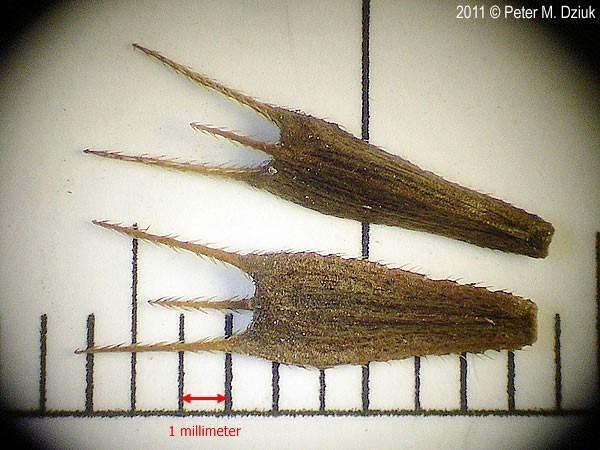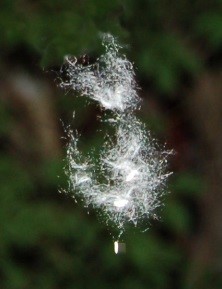Seed Dispersal is a plant adaptation that isn't always noticed, unlike the flower which is very visible. These adaptations are very important for plants so they can multiply effectively. We will break seed dispersal down into three categories: dispersed by animals/insects, dispersed by (non-living) nature, and dispersed by self.
Animal Dispersion
Seeds that are dispersed by animals, humans included, do so by way of consumption or by "hitch-hiking." Any type of berry or fruit would be an example of a seed that is spread by consumption (something eating it). These seeds have an adaptation to them that allows them to be unharmed while going through the intestinal tract until it gets deposited. Some fruits are very palatable creating a "win-win" situation: the plant has its seed dispersed and the animal receives nutrients from the fruit (think raspberries). Other fruits are not palatable, which creates a "win-lose" situation: the plant has its seed dispersed, but the animal gets sick from the fruit and receives no nutrients. Common Buckthorn (Rhamnus cathartica), an invasive exotic shrub, is one example of this. When this is the only food source for songbirds (Common Buckthorn is very aggressive and out-competes native vegetation), they are forced to eat the berries which causes a severe laxative reaction – hence the "cathartica" part of the Latin name – and results in extreme dehydration and fatigue; the final outcome may result in death if there is no other food source available.
 Hitch-hiking is another way seeds are dispersed by animals. These seeds are adapted with little barbs that allow the seed to get stuck on the fur of animals, or on clothing of people. As the animal travels with the seed stuck to its fur, the seed will often be released when it is rubbed against another object such as a tree or rock. Examples of this would be Beggartick (Bidens spp.) or Tick-trefoil (Desmodium spp.)
Hitch-hiking is another way seeds are dispersed by animals. These seeds are adapted with little barbs that allow the seed to get stuck on the fur of animals, or on clothing of people. As the animal travels with the seed stuck to its fur, the seed will often be released when it is rubbed against another object such as a tree or rock. Examples of this would be Beggartick (Bidens spp.) or Tick-trefoil (Desmodium spp.)
In some cases, for example when the "dispersal agent" is a migratory bird, animal dispersion has resulted in seed distributed of 1,000 miles from the host plant!
Non-living Natural Dispersion
 Non-living natural dispersion includes wind or water dispersion. In the case of wind dispersion, seeds can have different types of adaptations. One type has many small, fine hairs that give lift to the seed. Examples of this would Dandelion (Taraxacum spp.), Milkweed (Asclepias spp.), or Eastern Cottonwood (Populus deltoids) seeds.
Non-living natural dispersion includes wind or water dispersion. In the case of wind dispersion, seeds can have different types of adaptations. One type has many small, fine hairs that give lift to the seed. Examples of this would Dandelion (Taraxacum spp.), Milkweed (Asclepias spp.), or Eastern Cottonwood (Populus deltoids) seeds.
Another adaptation of wind-dispersed seed is known as a samara. This is a winged part of the fruit that allows the seed to get caught in the wind and fall slowly to the ground. This adaptation usually doesn't allow the seed to travel as far from the host plant as the seeds with hairs do. The seed can be located at one end of the samara – Maples (Acer spp.) and Ashes (Fraxinus spp.) – or in the middle of the samara – Elms (Ulmus spp.). This adaptation, especially in the maples, will act like a helicopter falling to the ground.
Another natural dispersion adaptation is by water, a great example of this would be water/pond lilies (Nuphar spp.). Yellow Water Lily (Nuphar lutea) is the most common of the water lilies in Wisconsin. After the seeds become ripe, they are able to float on the surface of the water for about three days. This allows the seed to spread far enough away from the host plant, especially if there is a slight current or breeze.
Self-Dispersion
 This form of seed dispersion is probably my favorite! In this case, the seed is propelled from the plant by an explosion of the fruit, in plants such as Squirting Cucumber (Ecballium elaterium), or by catapulting it from the seed head, in plants such as Wild Geranium (Geranium maculatum) and Orange Jewelweed (Impatiens capensis). In some cases, seeds have been known to travel up to 50 feet from the host plant!
This form of seed dispersion is probably my favorite! In this case, the seed is propelled from the plant by an explosion of the fruit, in plants such as Squirting Cucumber (Ecballium elaterium), or by catapulting it from the seed head, in plants such as Wild Geranium (Geranium maculatum) and Orange Jewelweed (Impatiens capensis). In some cases, seeds have been known to travel up to 50 feet from the host plant!
There are also less forceful propulsion methods. Some of these are found in the Legume (pea or bean) family, which all form seed pods. When they are dry and ready to be dispersed, the pod will break open and the seeds will get released and drop fairly close to the host plant.
Wild Rye (Elymus spp.) has a particularly interesting adaptation. When the seed gets dispersed from the plant (either by self- or animal dispersion), it actually digs itself a hole in the ground! The seed of Wild Rye has a long awn (it looks like a long hair coming from one end of the seed) that interacts with the moisture in the air. As the humidity changes, the awn starts twisting which forces the seed to twist. This action drills the seed into the ground. The seed also has small hairs on it that inhibits the seed from being pulled out of the ground as it's drilling into it.
Get Involved!
If you would like to see this method in slow motion, watch this video produced by BBC, or come volunteer at any of our land stewardship opportunities and talk with us.





